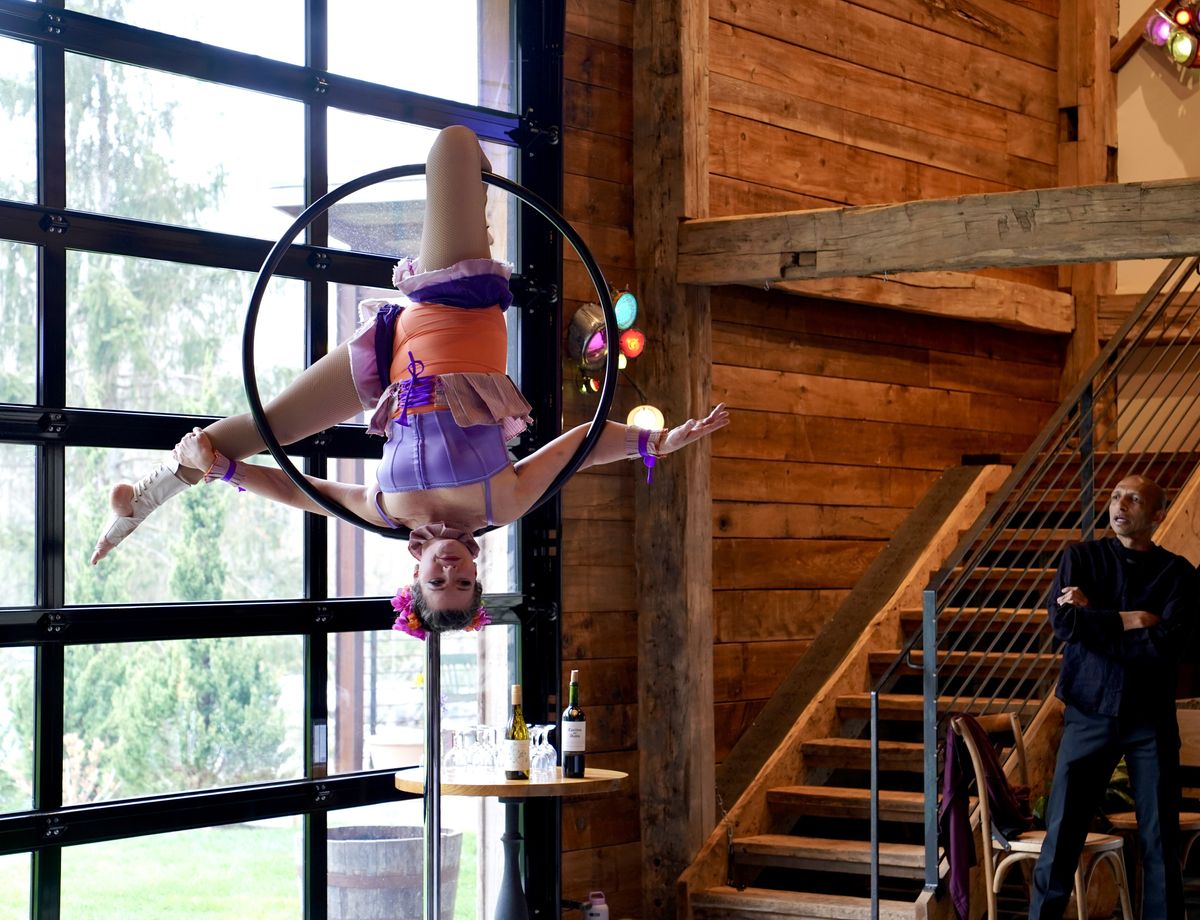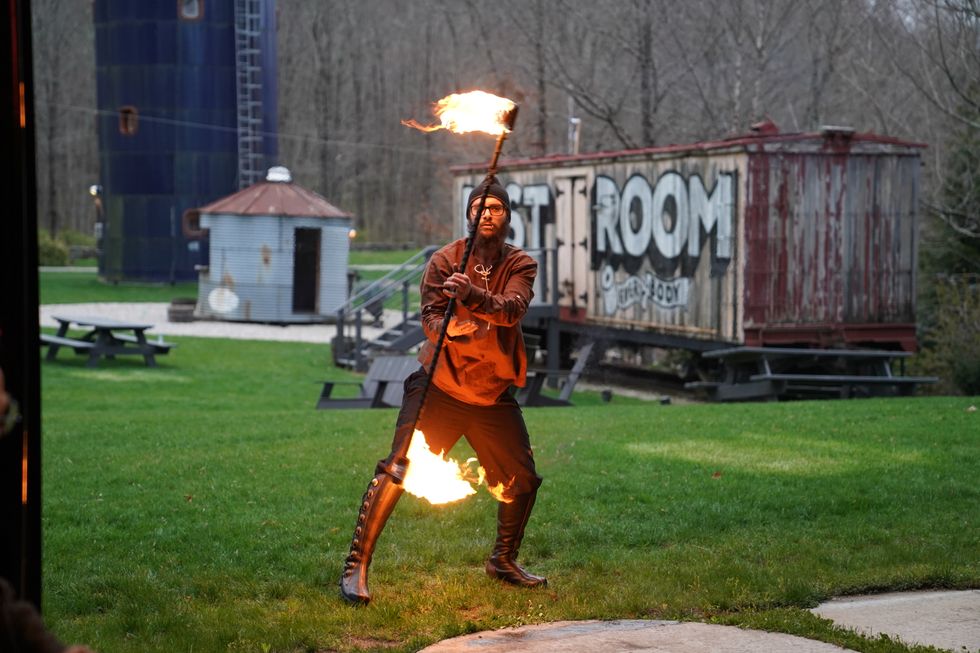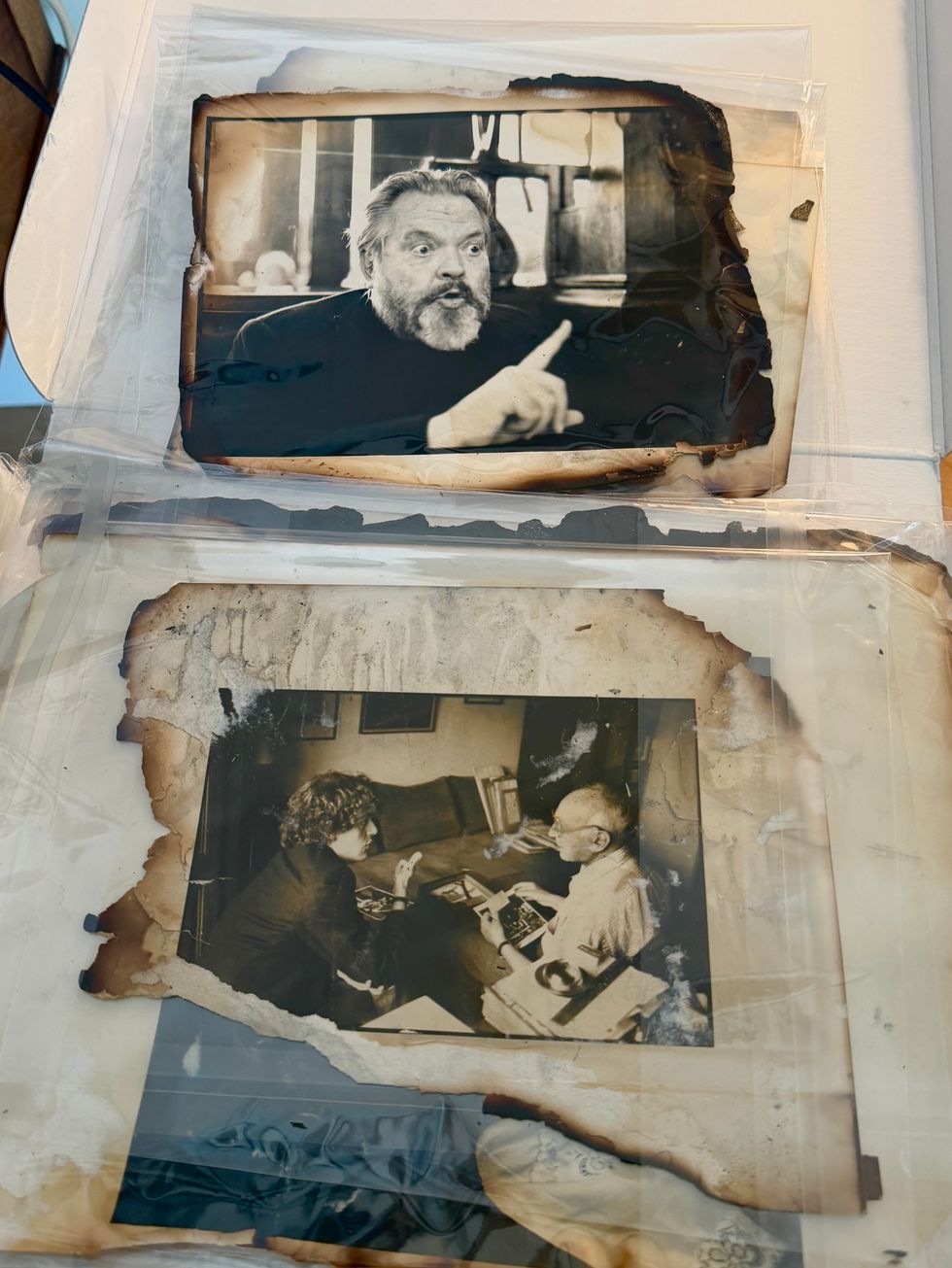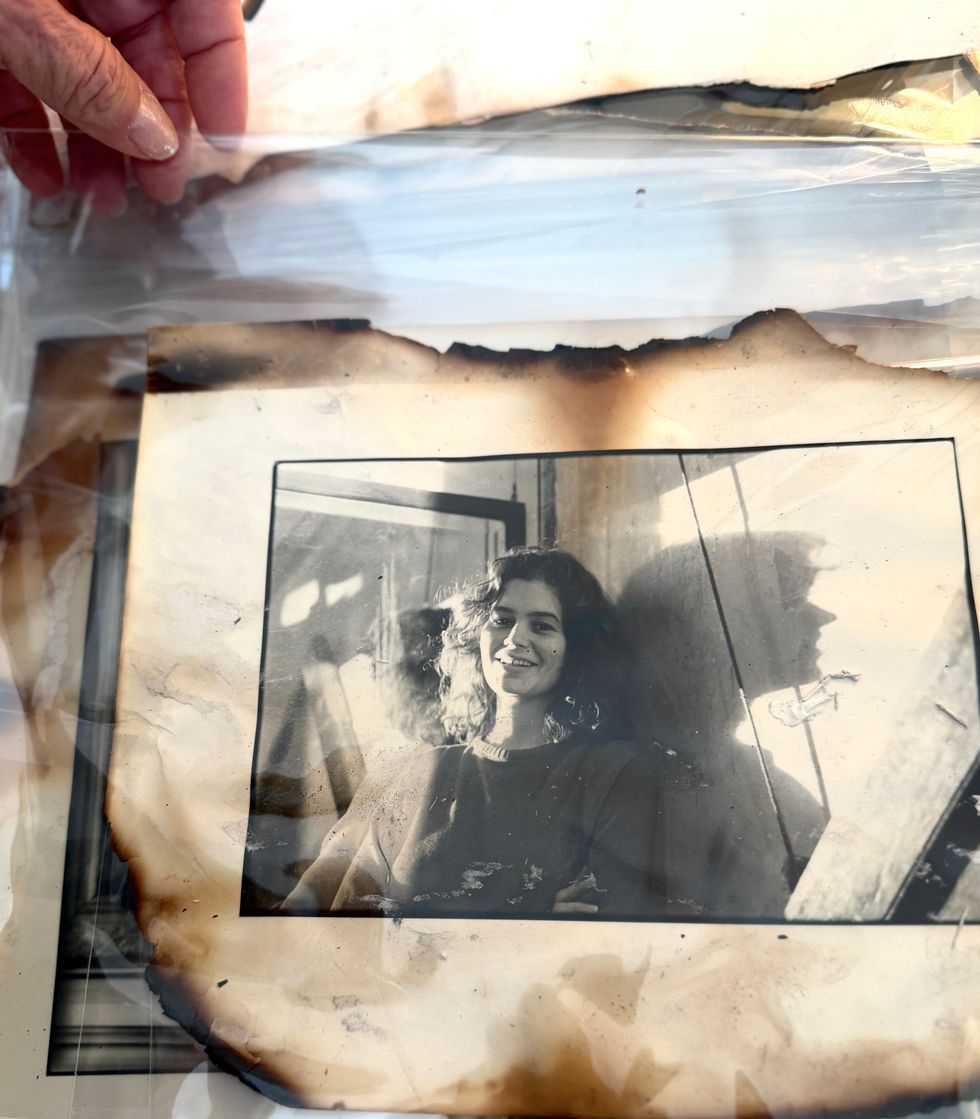NWCT Arts Council: Arts Connected

Matica Circus duo from Harwinton, Connecticut performing at NWCT ARTS Connected event in May
Jennifer Almquist

Matica Circus duo from Harwinton, Connecticut performing at NWCT ARTS Connected event in May
The Northwest Connecticut Arts Council (NWCT Arts) recently held Arts Connected, their first fundraiser, at the Spring Hill Vineyard in Washington, Connecticut. The evening celebration, a combination of Fellini movie, carnival, and Renaissance Fair, featured an aerialist from Matica Circus in Harwinton, and a flame and flow performer out in the courtyard under the stars. Momix, based in Washington Connecticut, under the artistic direction of founders Moses Pendleton and Cynthia Quinn, also performed. Two dancers wore Jeff Koons-style inflated red dog suits, and Momix dancer Jared Bogart wafted through the space wearing an immense, two-stories tall silk fan. Persian calligraphic painter Alibaba Awrang created a community work of art, while Ameen Mokdad, a violinist from Iraq, made music with Hartford’s Cuatro Puntos Ensemble. A young musician, Adelaide Punkin, performed an original song from the balcony of the vast space, while a giant puppet from Sova Dance and Puppet waltzed through the festivities. DJ Arvolyn Hill from Kent spun the tunes, an African drum circle set the rhythm, and there was abundant food and drink for the gathered crowd.
NWCT Arts is one of 8 regional Arts Councils designated by the Connecticut Office of the Arts, a branch of the Department of Economic and Community Development (DECD). The mission of NWCT Arts is to “elevate the role of the arts to build community and economic vitality.” The NWCT Arts was founded by Amy Wynn in June of 2003 in collaboration with the Northwest Connecticut Community Foundation and the Northwest Connecticut Chamber of Commerce.
Brian Boye, Litchfield County resident, Vice President at Nike Communications, NWCT Arts board member emphasized “Our goal with Arts Connected was to highlight the rich tapestry of artists that live and work in our community. We are blessed with such a diverse range of talent, from world-class dance ensembles like Momix to incredible visual artists like Stace Dillard who work solo in studios across our 25 towns. I am thrilled that we were able to feature more than 80 local artists in a variety of formats throughout the event. Our art gallery featured more than 60 artists and we had live performances from musicians, calligraphers, DJs, drummers, photographers, dancers, aerialists, and singers. It was such a joy to witness the community coming together to celebrate all this talent.”
Steph Burr began her time as Executive Director of NWCT Arts in the heart of the Covid pandemic. A fierce advocate for artists, Burr had to immediately shift gears to create the NWCT Artist Emergency Relief Fund to aid local creatives through the hardship caused by COVID-19. NWCT Arts raised funds to support artists in financial distress. 51 artists from 13 towns in the region applied for help; arts educators, performing artists, musicians, commercial artists, fine artists, and artisans who depend on craft fairs and farmer’s markets to sell their wares. 73% of the applicants were not receiving unemployment and 31% of those applying were housing insecure. Burr is also an artist who lives in Torrington.
For 20 years, the Arts Council has been advocating for artists and the creative process in our region. They empower, facilitate, network, collaborate, and secure funding for local arts initiatives. Burr knows it is still hard for new arts organizations, and artists, to achieve lift-off. Funding for the arts has been cut back by the State to pre-pandemic levels with no adjustment for inflation. Burr would like to see greater advocacy from more established artists and organizations to help emerging artists get on their feet.
Board member Boye said, “We want to raise the profile of the Northwest Connecticut Arts Council, which typically works behind the scenes to ensure that artists and arts organizations can continue to thrive in our 25 towns. We’ve learned over the past few years that the arts are a major economic driver here. When we have a thriving arts community, people will visit our towns, shop in our stores, eat in our restaurants and stay in our inns. In 2022, the non-profit arts and culture industry generated more than $30 million in economic activity in our community. But there are a lot of challenges artists face to live and work here. Our mission is to ensure that there’s a network of support for them. We know that access to their work brings joy to us individually, but it also positions our region as a cultural destination that has a positive economic effect that benefits everyone.”
NWCT serves the towns of Barkhamsted, Bethlehem, Burlington, Colebrook, Cornwall, Falls Village/Canaan, Goshen, Hartland, Harwinton, Kent, Litchfield, Morris, New Hartford, New Milford, Norfolk, North Canaan, Plymouth, Roxbury, Salisbury/Lakeville, Sharon, Thomaston, Torrington, Warren, Washington, and Winchester/Winsted.
Sunday Fisher, chair of the board of directors, lives in Sherman and is an operational strategist after decades working in the retail world. “Northwest Connecticut is truly a special place, renowned as a sanctuary where artists have historically come to create and find inspiration. It’s my hope that our region be recognized as a vibrant hub for all forms of art. At the Council, we are deeply committed to honoring our rich history as stewards of this artistic legacy while also forging paths that ensure the arts not only survive but thrive. Balancing these roles is essential to fostering an environment where the arts can flourish and enrich our community for generations to come.”
“The arts are a powerful economic engine for our region and are very worthy of expanded investment,” said Burr. “Our nonprofit arts organizations connect our communities and help define our culture. They also attract substantial revenue to the local economy and support many jobs and small businesses. It is no easy feat to do both.” NWCT Arts is working closely with the Connecticut Department of Tourism as the arts are responsible for increased tourism in the region.
Our state representative Maria Horn agrees with Burr. “Arts and culture are a defining part of the Northwest Corner for those who live here and those who visit the region. Communities like ours that support arts and culture not only enhance their quality of life— they also invest in their economic well-being. We know this because we’ve studied it.”

Stephen Gass, former President of sesamestreet.org, and vice board chair said, “When I was asked to join the board of the NWCT Arts Council, I said “OK” with one condition: the organization embraces the idea that our area’s sustainability does not rely solely on caring for our environment. Rather, given the countless ways the arts can feed our collective souls, fuel curiosity, create shared experiences, and critically serve as economic drivers, we champion the idea that the arts are essential to our well-being. Just as environmental sustainability requires that we think beyond a town’s borders, the NWCT Arts Council’s 25-town purview provides the “big picture” perspective that helps ensure a rich, far-reaching, and fertile arts and culture landscape for us all.”
Executive Director Burr, whose dream for NWCT Arts is to provide equity in the arts, reiterated their underlying credo, “As an arts organization, we work to put the voices that are most unheard at the forefront to empower the movement toward creative justice. The arts are a human right and bring us together to celebrate cultural diversity. Everyone deserves access to art and culture, to be included, and to feel a sense of belonging. We are dedicated to serving the needs of everyone regardless of race, age, physical or mental ability, religion, gender, sexual orientation, or economic status.”
Burr, “Our plan is grounded in the belief that the arts have the power to transform lives and communities, and that by supporting artists and the creative process, we can create a more vibrant and prosperous region. I am so grateful for the support of our board, staff, and stakeholders. I am confident that together we can achieve our vision of a region where artists can thrive, and everyone can experience the arts.”
NWCT Arts recognizes the positive impact the arts have on our mental health. Access to arts and culture is a universal human right, meeting both a social and psychological need. Jackie Armstrong, an educator at MOMA, said “Art can harness the healing power within each of us and help bring us into community with one another. When in front of an artwork, we are connected to the artist and to others who have experienced it. And connection, to us and others, is at the core of art and healing.”
Board chair Fisher continued, “As we reflect on the success of our first annual fundraiser, we’re filled with optimism about the future of the arts in Northwest Connecticut. This event has crucially boosted our ability to provide artists with the everyday tools they need to flourish. Our aim is to elevate the arts across the towns we serve, emphasizing not only their role in fostering community connections but also their significant impact as an economic driver. Looking ahead, we envision a partnership where municipalities seamlessly invest in arts and culture, ensuring every resident has access to these enriching experiences. Our first annual event marks a pivotal step towards making that dream a reality.”
Burr summed it up, “Our plan is grounded in the belief that the arts have the power to transform lives and communities and that by supporting artists and the creative process, we can create a more vibrant and prosperous region. I am so grateful for the support of our board, staff, and stakeholders. I am confident that together we can achieve our vision of a region where artists can thrive, and everyone can experience the arts.”
How can people help the NWCT Arts Council? They currently have eighty paid members. Information on how to join or support them and listings of future arts events can be found by going to www.artsnwct.org
CARE GIVER NEEDED: Part Time. Sharon. 407-620-7777.
SNOW PLOWER NEEDED: Sharon Mountain. 407-620-7777.
Weatogue Stables has an opening: for a part time or full time team member. Experienced and reliable please! Must be available weekends. Housing a possibility for the right candidate. Contact Bobbi at 860-307-8531.
Deluxe Professional Housecleaning: Experience the peace of a flawlessly maintained home. For premium, detail-oriented cleaning, call Dilma Kaufman at 860-491-4622. Excellent references. Discreet, meticulous, trustworthy, and reliable. 20 years of experience cleaning high-end homes.
Hector Pacay Service: House Remodeling, Landscaping, Lawn mowing, Garden mulch, Painting, Gutters, Pruning, Stump Grinding, Chipping, Tree work, Brush removal, Fence, Patio, Carpenter/decks, Masonry. Spring and Fall Cleanup. Commercial & Residential. Fully insured. 845-636-3212.
The Villas Cleaning Team: Owner-Operated. Reliable, detailed cleaning by a trusted husband-and-wife team. Homes & Offices. Airbnb. Small Post-Construction. Commercial. Windows. Laundry. Consistent cleaners every time. Competitive rates. Flexible scheduling. Call/Text: 903-918-2390. Dave Villa for a free estimate.
Estate/Tag Sale: 168 Johnson Road, Falls Village CT. Friday Saturday Sunday, December 5th-7th. Total house contents, furniture, antique and vintage collectables, costume jewelry, shed stuff, basement stuff, stairs chairlift, some art. Fri, Sat 9-4 and Sunday 9-noon. A Tommy sale, come and get it!!
PUBLISHER’S NOTICE: Equal Housing Opportunity. All real estate advertised in this newspaper is subject to the Federal Fair Housing Act of 1966 revised March 12, 1989 which makes it illegal to advertise any preference, limitation, or discrimination based on race, color religion, sex, handicap or familial status or national origin or intention to make any such preference, limitation or discrimination. All residential property advertised in the State of Connecticut General Statutes 46a-64c which prohibit the making, printing or publishing or causing to be made, printed or published any notice, statement or advertisement with respect to the sale or rental of a dwelling that indicates any preference, limitation or discrimination based on race, creed, color, national origin, ancestry, sex, marital status, age, lawful source of income, familial status, physical or mental disability or an intention to make any such preference, limitation or discrimination.
Sharon, CT
TAG SALE: SATURDAY, DECEMBER 6, 10:00 AM - 2:00 PM, 135 Sharon Mountain Road, Sharon, CT 06069. Clearing things out before the holidays! Stop by for a great mix of items, including: Kitchenware, Small pieces of art, A few pieces of furniture, Clothing, Books, And more assorted household items. Easy to find, everything priced to sell. Hope to see you there!
Legal Notice
Notice of Formation of Studio Yarnell LLC
Notice of Formation of Studio Yarnell LLC. Articles of Organization filed with the Secretary of State of New York (SSNY) on October 20, 2025. Office location: Dutchess County, NY. SSNY has been designated as agent of the LLC upon whom process against it may be served. SSNY shall mail a copy of any process to: 279 McGhee Hill Road, Millerton, NY 12546. Purpose: Marketing consultancy.
11-13-25
11-20-25
11-27-25
12-04-25
12-11-25
12-18-25
Legal Notice
Notice of Formation of a Limited Liability Company (LLC). The name of the LLC is: Kim’s Business LLC. Articles of Organization were filed with the Secretary of State of New York (SSNY) office on: 11/8/2025. The County in which the Office is to be located: Dutchess. The SSNY is designated as agent of the LLC upon whom process against it may be served. The address to which the SSNY shall mail a copy of any process against the LLC is: 420 Quaker Hill Rd Pawling, NY 12564. Purpose: any lawful activity.
11-20-25
11-27-25
12-04-25
12-11-25
12-18-25
12-25-25
Legal Notice
Notice of Formation of DULCIFY LLC Art. Of Org. filed with SSNY on 09/04/2025. Office Location: 56 South Center Street, Millerton, Dutchess County, NY 12546. SSNY designated as agent of the LLC upon whom process against it may be served. SSNY shall mail process to the Dulcify LLC, 56 South Center Street, Millerton NY 12546.Purpose: Any lawful purpose.
11-27-25
12-04-25
12-11-25
12-18-25
12-25-25
01-01-26
Legal Notice
PLEASE TAKE NOTICE that the Pine Plains Town Board will hold a Special Meeting on December 10, 2025, at 6:00 pm. Said meeting will be held at the Community Center, 7775 Rte.82, South Main Street, Pine Plains, NY 12567. Purpose of the meeting is a public forum about the New Town Hall. The meeting is open to the Public. Dated: November 20, 2025.
BY ORDER OF THE TOWN BOARD
Madelin Dafoe
Town Clerk
12-04-25
NOTICE OF
PUBLIC SALE OF
PERSONAL PROPERTY
GLOBAL SELF STORAGE
Notice is hereby given that the undersigned self storage unit(s) will be sold at a public sale by competitive bidding, in their entirety to the highest bidder, on or after December 26th, 2025, to satisfy the lien of Global Self Storage for rental and other charges due from the undersigned. The said property has been stored and generally described below is located at the respective address. Although, the auction will be held via www.StorageTreasures.com, the sale is made in person at the facility: 3814 Route 44, Millbrook, NY 12545.
Friday, December 26th, 2025
#224 Eva Mort
The terms of the sale will be cash only & must be paid for at the time of sale. All goods are sold as is. Global Self Storage reserves the right to withdraw any or all units from the sale at any time. All contents must be removed within 72 hours or sooner.
12-04-25
12-11-25
PINE PLAINS
TOWN BOARD
NOTICE OF
PUBLIC HEARING
PROPOSED INCREASE IN WATER RATES AND FEES FOR THE PINE PLAINS WATER IMPROVEMENT AREAS
PLEASE TAKE NOTICE that the Pine Plains Town Board shall hold a public hearing on December 18, 2025 at 7:00 p.m. at the Pine Plains Town Hall, located at 3284 Route 199, Pine Plains, New York, on the proposed increase in water user rates and fees for services of the Pine Plains Water Improvement Areas. The proposed water user rates shall be increased from the current minimum usage fee of $45.00 to $50.00 for the first 9,000 gallons recorded, and from $5.80/1,000 gallons to $6.20/1,000 gallons recorded over the initial 9,000 gallons recorded. The purpose of these rate increases is to offset substantial increases in electricity, materials and supplies to operate and maintain the Pine Plains Water Improvement Area Water System. Any person wishing to be heard shall be given an opportunity to do so at said public hearing. A copy of the proposed rate change will be available for inspection at the Town Clerk’s office at regular business hours. Dated: November 20, 2025.
BY ORDER OF THE PINE PLAINS TOWN BOARD
MADELIN DAFOE,
Town Clerk
12-04-25
Anne Day is a photographer who lives in Salisbury. In November 2025, a small book titled “Les Flashs d’Anne: Friendship Among the Ashes with Hervé Guibert,” written by Day and edited by Jordan Weitzman, was published by Magic Hour Press.
The book features photographs salvaged from the fire that destroyed her home in 2013. A chronicle of loss, this collection of stories and charred images quietly reveals the story of her close friendship with Hervé Guibert (1955-1991), the French journalist, writer and photographer, and the adventures they shared on assignments for French daily newspaper Le Monde. The book’s title refers to an epoymous article Guibert wrote about Day.
On Dec. 11, at 6:30 p.m., at the White Hart Inn in Salisbury, Day and Weitzman will share their memories in a conversation moderated by noted designer Matthew Patrick Smyth. The event is organized by Oblong Books and the Scoville Library.
Fresh home from her exhibition and book signing in Paris, Day sat in her Salisbury aerie high above the distant hills, her daughter’s black cat on her lap. She told the story of “Les Flashs d’Anne,” and the kismet that spurred its evolution.
In 2024, afterlearning that Day had worked with Guibert in New York and Paris, Weitzman — the author of numerous books about Guibert —saw her salvaged images, sought her out and announced, “We must do a book together.”
Weitzman writes in the book’s prologue, “This book is the dreamlike, uncanny result of that serendipitous encounter with a remarkable woman.”

During the 1980s, Day was a working photographer living on Fifth Avenue. A friend, the editor of Le Monde, asked whether Guibert, on his maiden voyage to New York, could stay with her. “I remember it was a cold night when Hervé showed up at my door,” she said.“His flight had just gotten in from Paris and he had this big box of Guerlain perfume. It was wrapped in beautiful pink paper. Within four minutes, we were friends.”
Thus began a whirlwind collaboration that took them from Manhattan, where they interviewed André Kertész, to Paris where they dined with Henri Cartier-Bresson and Duane Michals, and on to interviews with Isabelle Huppert, Gina Lollobrigida, designer Madeleine Castaing, Orson Welles and other luminaries of that time.
Day never saw Guibert after 1983. “Hervé got AIDS in the late ’80s and was quite militant. He now has a following of young people,” Day saidwistfully. During his final days, Guibert wrote five books based on his existential journey.

Day recalled the devastating house fire in which her family tragically lost their friend Maria Paz Reyes and their dog. Day survived by jumping from the second story. A lifetime of images, negatives and slides were lost or damaged. “To lose pictures is like losing friends. Everything was piled into metal file cabinets in my studio. All my negatives and slides were packed in tight. The fire started at the farthest point from there as possible. It was the only thing that wasn’t destroyed— every other single thing was gone. Nothing left. It was raining, so my friend Christopher covered everything with a tarp. The fabulous part of this story is how much help I had from my town, which gave me the empty firehouse to lay out everything to dry. Friends came from near and far to help. Some days I had ten volunteers, and it went on for a month, which gave me something to move forward with. It was so tragic and awful.”

A veteran photojournalist, portrait, wedding, and architectural photographer, Day created images for five books featuring the architecture of the Library of Congress, the U.S. Capitol, and the New York Public Library. She covered events in Cuba, Haiti and South Africa, where she took an iconic image of Nelson Mandela emerging from his prison cell. Her commissioned images of four Presidential Inaugurations are featured in the Smithsonian. Her work has appeared in Newsweek, Time, The New York Times, The Washington Post, Fortune, Paris Match and Vogue. She was the editor of Compass at the Lakeville Journal and The Millerton News.
Currently, she enjoys shooting digital photographs of nature. “I am interested in migration, large groups of birds and insects. I’ve been to New Mexico to photograph monarchs, Nebraska to photograph Sandhill cranes, and Ireland to photograph a murmuration of starlings.”
Day summed up her life: “Things just happened to me.”
Tickets to the event at The White Hart Inn on Dec. 11 are available at oblongbooks.com
In 1983, writer and performer Nurit Koppel met comedian Richard Lewis in a bodega on Eighth Avenue in New York City, and they became instant best friends. The story of their extraordinary bond, the love affair that blossomed from it, and the winding roads their lives took are the basis of “Apologies Necessary,” the deeply personal and sharply funny one-woman show that Koppel will perform in an intimate staged reading at Stissing Center for Arts and Culture in Pine Plains on Dec. 14.
The show humorously reflects on friendship, fame and forgiveness, and recalls a memorable encounter with Lewis’ best friend — yes, that Larry David — who pops up to offer his signature commentary on everything from babies on planes to cookie brands and sports obsessions.
Koppel has good friends in the Pine Plains area and she calls the opportunity to present the piece at the Stissing Center a gift to her and her artistic process, which she shares with her son, Gideon McCarty, who serves as her director and dramaturg.
“He is the one person I listen to,” said Koppel.She credited him with helping her shape, in her own words, “real events from her life with Lewis.” For Mother’s Day this year, McCarty gave her the time to further develop the material and Koppel worked uninterrupted for 12 hours to hone and bring the piece to its current form. She plays 11 characters, not through impersonation but by presenting their authentic voices.
Koppel is clear that writing this piece was the right way for her to respond to Lewis’ passing in 2024, and that theatre is the right way to share it with others. “I wanted to have artistic control over the development process,” she said, and to bring to life her romantic relationship with Lewis, their experiences in New York City comedy clubs, and their neurotic New York friends. She also is open to opportunities to expand further on the material, perhaps in film or TV, as she still has a lot to say.
Koppel hopes primarily that people will be entertained by the world of the play. “I’m a pie-in-the-face kind of person and I want the play to give everyone a good laugh.” Considering her cast of characters, “Apologies Necessary” promises to offer plenty of laughs —plus much more.
“‘Apologies Necessary’ continues Stissing Center’s tradition to serve as a platform for new works of theater, providing playwrights with the opportunity to showcase their work and hone their craft,” said Patrick Trettenero, executive director of the Stissing Center. “We are excited to have Nurit present this reading of her new work in progress.”
Running time: approx. 90 minutes. Sunday, Dec. 14 at 7 p.m., Downstairs at Stissing Center. Tickets are vailable at thestissingcenter.org or 518-771-3339.
Richard Feiner and Annette Stover have worked and taught in the arts, communications, and philanthropy in Berlin, Paris, Tokyo, and New York. Passionate supporters of the arts, they live in Salisbury and Greenwich Village.